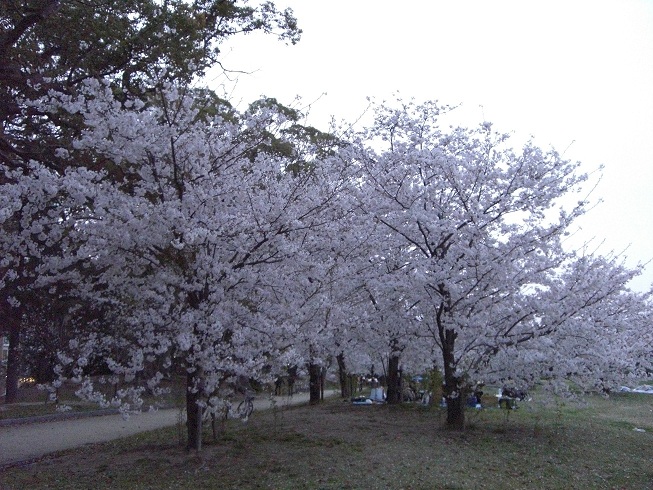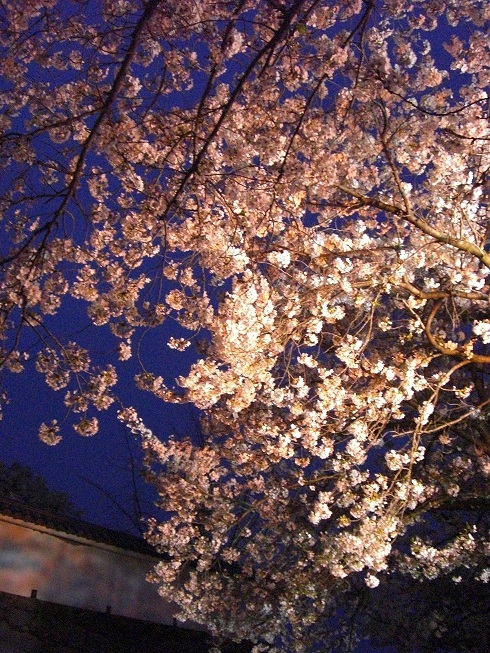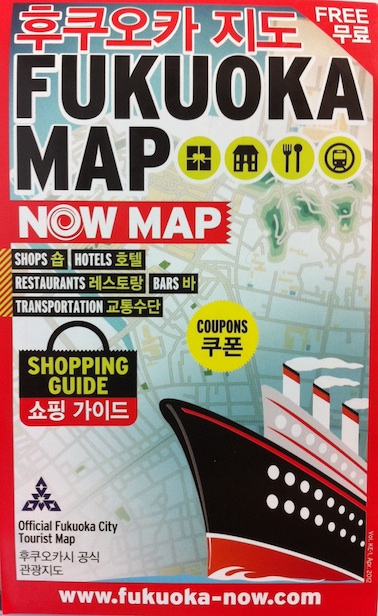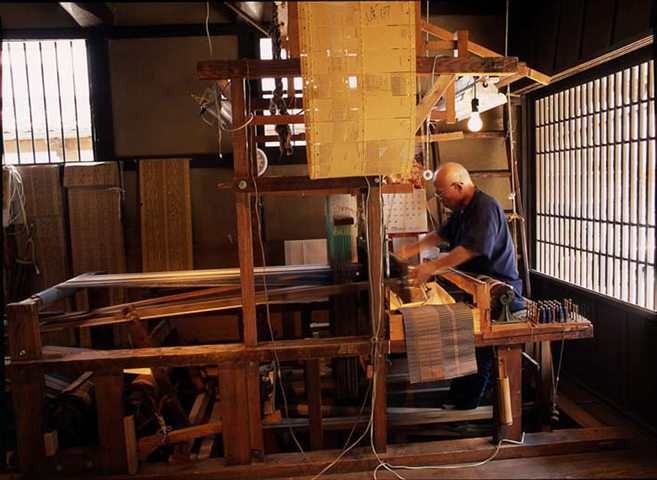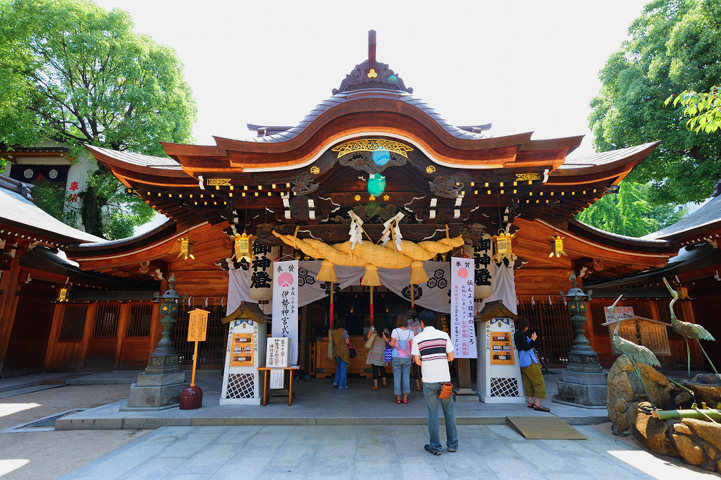Recommended Plans
OC's guide to Fukuoka
- Masuhara, General chair
- Chiba, Organizing co-chair
- Ubayashi, Organizing co-chair
- Kamei, Web chair
- Kamina, Organizing member
- Sato, Organizing member
- Takeyama, Design
- Optional tours
Hidehiko's recommendation for travel in and around Kyushu, Japan
Assuming you are planning a day trip within Kyushu, I would like to recommend a few places so as to save your time in reading through the Lonely Planet's guidebook. Why within Kyushu? My guess is that you have already been to popular cities like Kyoto, or you will probably go to such cities on your next visit. But you might not be able to come to Kyushu soon. In fact, there are a lot of interesting places in Kyushu where you should visit. Let's take this chance to explore this exciting island.
Kumamoto Castle
There are many old castles in Japan, and of course in Kyushu. But if
you expect a castle with a big keep, you should be careful, as many
castles have lost their keep. Kumamoto Castle is one of the castles
that has maintained its keep (though reconstructed) and has convenient access
from Fukuoka. It is also a good chance to ride the Shinkansen!
(Approx. 1 hour from Fukuoka)
http://en.wikipedia.org/wiki/Kumamoto_Castle
Gunkanjima (Battleship Island)
Do you like to visit ruins? Gunkanjima (Battleship Island), or
officially Hashima, is a unique place for ruin lovers. The island was
reclaimed from shallows on top of undersea coal mine, and surrounded
by sea walls, which makes its outlook like a battleship. Once
populated with more than 5000 miners and their families, it is now
uninhabited. You can visit the island by using tour boats from
Nagasaki port (2 hours from Fukuoka).
http://www.japan-guide.com/e/e4414.html
Mount Aso
As you know, there are many active volcanoes in Japan. Do you wonder
which one you should visit? Mount Aso is known by its huge and scenic
caldera. Even though the volcano is active, there are villages,
streets and even railroads inside the caldera. (Approx. 2 hours from
Fukuoka, 1 hour from Kumamoto.)
http://en.wikipedia.org/wiki/Mount_Aso
Nagasaki
A port founded in the late 16th century, Nagasaki has been a gateway
of Japan to outside, in paticular China, Portugal and the Netherlands.
The city center is comfortably small for walking around, and has many
historic architectures and gardens with European influence and the
tragic memory of atomic bombing. (Approx. 2 hours from Fukuoka)
http://en.wikipedia.org/wiki/Nagasaki
http://www.japan-guide.com/e/e2162.html
Hanami
If we are lucky, we will be surrounded by blossomed cherry trees
everywhere during the conference week. A Japanese way to celebrate
spring is to drink under cherry trees. Let's go to a park with your
favorite beverages and snacks, and find an empty space under a tree
(which might be difficult, though). Most convenience stores sell
alcohol drinks, include Sake and Shochu. Bringing a plastic picnic
sheet would be useful. Maizuru park is one of the major Hanami spots
in Fukuoka, and just two subway stops from the city center (Tenjin).
>From the conference site, it is also easy to get to a park located on
the other side of the bay (Uminonakamichi) by taking a ferry from a
pier close to the congress center.
http://www.japanlinked.com/about_japan/fha/hanami.html
http://www.japan-guide.com/e/e4806.html
Disclaimer: I actually have visited none of these places. My recommendations are based on my trusted friends, who have visited there, or who have been/are living there. In fact, I really would like to visit these places! (Special thanks to Raffi Kahtchdorian for checking the text and for his recommendation of Nagasaki.)
Chiba's guide to Fukuoka
Welcome to MODULARITY: aosd•13! and, of course, Fukuoka, a beautiful city in West Japan. Before writing my guide, I must say that I am not a local person in that city. I was born in Tokyo and still living in Tokyo, which is 900 km far from Fukuoka. But I have visited this city many times as a tourist and every time enjoyed the stay there (mainly sea food..) So my guide is from the viewpoint of a tourist living in a different city.
Going to Fukuoka from Tokyo is easy. Many airplanes are flying back and forth between the two cities from early morning to night. Fukuoka airport is amazingly well connected to the city center, just several minutes train-ride. Note that I am in Tokyo, which is famous for the airports located very far from the city. Let me tell you just in case you want to enjoy an extra stay in Tokyo before/after the conference.
Tokyo has two big airports, Narita (NRT) and Haneda (HND). Narita is not in Tokyo but in Chiba. So you must take a train or a highway bus. Skyliner is the fastest; it will take 40min and the cheapest (you can also take a local train on the same line but it takes more than an hour).
http://www.keisei.co.jp/keisei/tetudou/skyliner/us/index.html
http://www.keisei.co.jp/keisei/tetudou/skyliner/us/index.html
Many international flights arrive at Narita but several at Haneda. Haneda is within the city of Tokyo and most domestic flights depart from Haneda. If your travel agency recommends you a flight to Haneda, you should take it. By the way, to move from Narita to Haneda, you must take an airport bus or a connecting train. Both will take an hour to two hours.
Flights from Tokyo to Fukuoka are always busy since Fukuoka is a big city and many people visit there for their business. Taking the Shinkansen super-express train might be another option but Fukuoka is too far to go by train. If you want to do so, you should plan to enjoy one night stay in Kyoto. Going from Tokyo to Kyoto and from Kyoto to Fukuoka (the Hakata station) will take a just a few hours by train. The trip will be great experience.
Where do I stay in Fukuoka? I usually stay at a hotel near Tenjin station. Tenjin is a town where you can see many hotels, shops, bars, pubs, and everything. But any hotels near a subway station will be good. Fukuoka is a compact city. Moving between towns is quick and easy. Prices are around 5000 to 10000 yen. In my sense, the price range is similar to one in a big European city. If you book a hotel with 100 euro in Fukuoka, you would enjoy a stay at the hotel with a similar quality in Europe. Maybe the stay in Fukuoka would be better depending on a hotel you imagine.
Where should you go in Fukuoka? Ah... I don't know. Dazaifu is a famous shrine, built over the grave of a famous scholar in the 9th century. We organizing team are planning a conference tour to that shrine; so let's go there and pray that your next paper will be accepted by MODULARITY: aosd•14! I bet the acceptance ratio of the prayers' papers would be higher than the average.
We are looking forward to seeing you all in Fukuoka,
Shigeru Chiba
Organizing co-chair of MODULARITY: aosd•13
Ubayashi
Fukuoka is one of the oldest cities in Japan. There are many historical places including Kushida Shrine, Fukuoka Castle, and so on. Hakata Gion Yamakasa, one of the most famous festivals in Japan, is dedicated to Kushida Shrine. It is fifteen minutes walk from the conference venue. You can experience traditional Japanese culture. Maizuru Park is built around Fukuoka Castle. The cherry blossoms are in their full glory in spring. I recommend that you visit this park in the evening. The cheery blossoms lit up with streetlamps are so cool. You will be fascinated to discover the heart of Japanese beauty. Ohori Park, the neighborhood of Maizuru park, is the most largest park in Fukuoka. This park is a symbol of Fukuoka city. You can enjoy walking and a boat trip. Fukuoka City Art Museum is placed in Ohori Park. Art paintings of well-known painters such as Salvador Dali, Miro, Chagall, and Leonard Foujita are exhibited in this art museum. I recommend that you appreciate pictures if you are interested in art paintings.
Kamina's introduction to Fukuoka
Since I am not a resident of Fukuoka, I would like to introduce Fukuoka from the viewpoint of a resident of Tokyo. Fukuoka is famous in Japan for its many delicious foods and traditional crafts, and exhibitions of food and products from Fukuoka have been held in Tokyo a number of times.
As introduced in the Local Information section, there are a number of delicious local dishes in Fukuoka that you can try. I particularly recommend ramen, a noodle dish. I am a ramen-lover, and for me, the best ramen dish of them all is "Hakata-ramen," a Fukuoka speciality. When you eat ramen in Fukuoka, you can usually specify how long the noodle should be cooked. I recommend you order "katame" (firmer), which are cooked for a shorter time, because ramen noodles keep on softening after they are transferred to the soup broth, and the noodles used in Hakata-ramen are thin, so they soften up particularly quickly. If you still feel hungry after you finish eating, you can order "kaedama" (extra noodles), which will cost just a single coin. Make sure you don't drink all the soup broth if you want to order kaedama!
Since ancient times, Fukuoka has flourished as a hub for exchange between Asian cultures. There are many historical places, including castles, gardens and ruins, that are well worth a visit, and also several local speciality products that you may be interested in, such as Hakata Ningyo (dolls), and Hakata-ori (Fukuoka-stile textiles), one of the most famous textiles in Japan. Recently, mini-sized Hakata dolls and wallets made from Hakata-ori have become popular souvenirs, and are readily available in shops in Fukuoka.
Please enjoy your stay in Fukuoka! — Tetsuo Kamina
Kamei — Do you like a hot spring resort? —
I'm a hot spring lover. If you want to relax in a hot spring bath for a couple of days, I would like to recommend you that you visit *Yufuin*, which is one of the best popular hot spring resorts in Kyushu area (Please see the detail of *Yufuin* at Japan-guide - Yufuin).
How do you go to Yufuin? It's very easy!! There is a direct limited express from Hakata Station to Yufuin Station, called "Yufuin No Mori". The following is an example of travel time:
[Hakata Station] – JR Limited Express "Yufuin No Mori"(departure:10:18 / arrival:12:28) → [Yufuin Station]
Enjoy! — Yasutaka Kamei —
Sato's walking tour
I am a person who is not familiar with Fukuoka, but would like to introduce a kind of a walking tour. For the purpose of that, I have studied Fukuoka and visited there, and taken long walks around major sightseeing spots in Fukuoka. In fact, from my experience, a walking tour with an English map would be a great idea to get to know the charms of the town before participating the conference. This is because Hakata is the area full of new and old charms having many shrines and temples maintained the traditional culture.
The initial step for this short trip is picking up a copy of "Now Map" at the informations counters inside major stations like Hakata, Tenjin, shops and over 100 hotels. “Now Map” is a free detailed and colorful map of the city is Fukuoka City’s official tourist map this year. The following course includes popular tourist spots in Fukuoka taking 2-3 hours by walk.
- Sumiyoshi Shrine (10 min. from Hakata Station)
The original shrine among many other Sumiyoshi Shrines in Japan. And also worshipped as a god of sumo wrestling.
- Rakusuien Garden (1 min.)
A Japanese garden and a pond with carps. You can enjoy Maccha green tea in an authentic manner(300 yen).
- Canal City Hakata (5 min.)
Canal City is a commercial complex. This includes the Ramen Stadium gathering a lot of famous noodle shops from all over Japan.
- Shofukuji Temple (5 min.)
The first Zen temple constructed in Japan.
- Kushida Shrine (5 min.)
You can see a decorated float called Hakata Yamakasa exhibited used for the yearly Hakata Gion Festival.
- Hakata Machiya Folk Museum (1 min.)
This museum exhibits the life, culture and traditional craft workshops in good old days.
- Tochoji Temple (5 min.)
Fukuoka Daibutsu, the largest wooden Buddhist statue is sitting in the main hall.
If this doesn't meet your requirements, you can find other tours at:
- Fukuoka/Hakata Tourist Information Site (free, by yourself)
- Town Strolling tours by Fukutabi (paid, guided)
- Japan Kyusyu Travel (paid, guided, walking and bycycle)
By the way, although Dazaifu Tenmangu Shrine is the most popular place for Japanese tourists, expecially for school excursions, this is just because this shrine is dedicated to Michizane Sugawara, one of gods of learning in Japan. In my honor opinion, if you aren't going to be a Japanese student in the future, my plan would be enough to know historical parts in Japan ;-)
Otherwise, visit to the Kyusyu guide delivered by japan-guide.com, then see "Attractions" with choosing "uncategorized" and "sort by user rating" choice boxes. It displays popular sightseeing places sorted by rating that non-Japanese tourists actually voted. At this time, October 23, the top 11 of attractions are Yakushima, Kurokawa-onsen, Yufuin-onsen, Takechiko, Kirishima, Satsuma Peninsula, Aso, Huis Ten Bosch, Beppu-onsen, Kumamoto castle, Dazaifu. If I were you, I would extend my visit by choose the Kumamoto castle among them. Because traveling Yakushima is so much hard. Speaking of onsen, of course I love onsen :-), there are also many hotels providing hot spring facilities in Hakata as you can find out at the Yokanavi. Takechiko, Kirishima, Satsuma Peninsula and Aso are a lake, a mountain, a peninsula and a mountaion, respectively. On the other hand the Kumamoto castle is considered one of the three premier castles in Japan and takes only two hours from Hakata to Kumamoto by bus.
Please let me know if further information needed for making your original plan! I'll advice you.
View Hakata walking tour
A bullet trip to Tokyo via Hiroshima and Kyoto
I introduce three cities, Hiroshima, Kyoto, and Tokyo for post conference tours. The reason I chose these cities is that they are connected by the Tokaido and Sanyo Shinkansen, high-speed (270 km/h) train lines. You can enjoy wide part of Japan very quickly.
From Hakata station, please enjoy one hour trip on Shinkansen. After getting to Hiroshima, you should first visit Itsukushima shrine. Itsukushima shrine is one of three views of Japan, and famous for its structure on the water. In the downtown of Hiroshima, you will enjoy local foods such as oyster dishes and Hiroshima-yaki, which is a variation of Japanese pizza.
How about visiting Hiroshima Peace Memorial Park? It is a park dedicated to the 140,000 victims of the atomic bomb in 1945. In the museum located in the park, you can understand what happened in that day.
Next city is Kyoto, which is the most popular city for sightseeing. Many Shinto shrines and Buddhism temples in Kyoto are on the World Heritage List. Only for a few days, you cannot go around all of them. Here is a quick tour plan.
You cannot get back from Kyoto without seeing Kinkaku-ji temple. "Kin" means "gold" in Japanese. So there is a building wrapped in gold leaf. Next, let's go to Ginkaku-ji. "Gin" means "silver", but a building there is not wrapped in silver. Please feel wabi-sabi directly. Then Kiyomizu-dera is a temple with a huge veranda. The last one is Sanjusangen-dou temple, which has 1001 Senju-Kannon statues.
The final destination is Tokyo. What is the hottest place to visit in Tokyo today? It is no doubt, Tokyo Sky Tree. Tokyo Sky Tree, which is finished in 2012, is a tower for broad casting TV programs. It is 634 m high. It has observatories at 350 m and 450 m from the ground. If the weather is clear, you can look around Tokyo metropolitan area and Mt. Fuji.
Under the tree, there is a shipping center, Tokyo Sora Machi. I recommend going the souvenir shops street in it. You can find Japanese items such as chopsticks and a bowl. How about bringing back sweets unique to Sky Tree for your family and colleagues. In Japanese culture, we often buy gifts for them.
After enjoying Sky Tree, why don't you visit one of the most exciting area in Japan? It is Akihabara. You can reach there easily by bus shuttle from Sky Tree. Akihabara is the center of otaku culture. There are many shops selling Mangas and anime DVDs. You can also find maid cafe. Buki-ya (weapon shop) is also a wonderful shop, which sells replicas of katana (samurai sword)!
If you do not like such culture, how about visiting electrical stores? Along side streets next to the main one, there are tens of small stores, and you can get electric gadgets in very low prices. I often see visitors form abroad at used camera shops. If you need a tour guide, please ask students from Tokyo. They may know a lot about Akihabara.
Have a nice trip!
Fuminobu TAKEYAMA
Optional Tours
Nippon Travel Agency can arrange optional tours for you. Please contact to them if you want.
Nippon Travel Agency, Kyushu Event Convention Center
Masuda(Mr),Takada(Ms),
TEL:+81-92-451-0606 FAX:+81-92-451-0550
E-mail:fukuoka_ec [at] nta.co.jp
3-2-1,Hakata-ekimae, Hakata-ku, Fukuoka,812-0011, JAPAN.


